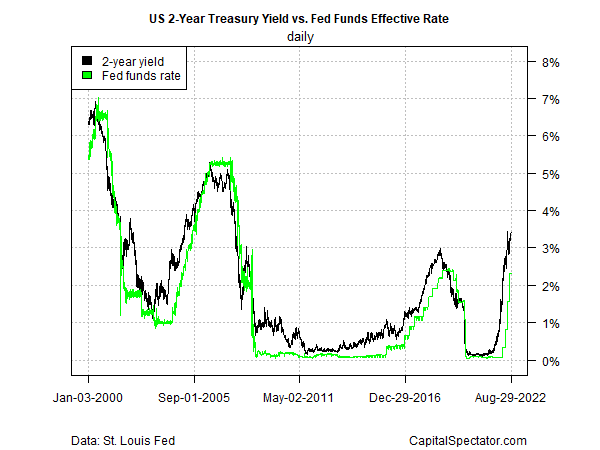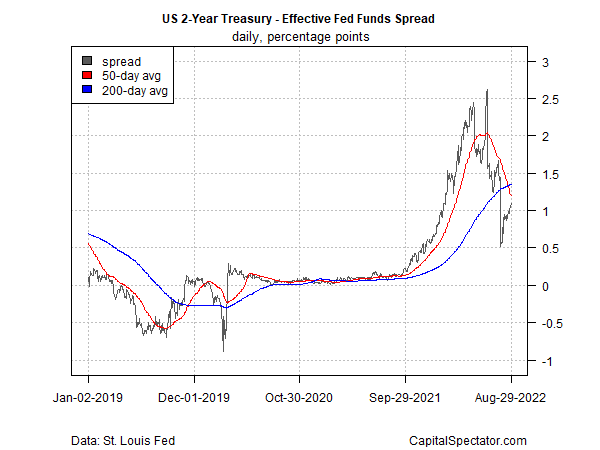Federal Reserve Chair Jerome Powell says more “pain” is coming, and the Treasury market believes him. The clearest sign of confidence in the central banker’s advisory is the renewed push higher in the 2-year Treasury yield (NASDAQ:UTWO), which is widely followed as a key benchmark for policy expectations.
After trading in a range in recent months, in the wake of a year-long surge, the 2-year rate pushed above the previous high set in June, rising to 3.46%. It’s no accident that the new high follows Powell’s hawkish speech last Friday at the Fed’s annual Jackson Hole symposium, where he warned that taming inflation would come at a cost.

“While higher interest rates, slower growth and softer labor market conditions will bring down inflation, they will also bring some pain to households and businesses,” he said.
A key question is how high will the Fed raise rates? The current Fed funds target rate is set at a 2.25%-to-2.50% range. Fed funds futures are pricing in a 73% probability this morning for another 75-basis-points hike at the Sept. 21 FOMC meeting.
Using the 2-year rate to guesstimate where Fed funds are headed (and where the rate hikes will peak) continues to imply that the policy rate will rise to the 3.5% range.

The spread for the 2-year less Fed funds rate in recent weeks recently suggested that the upside momentum for rate hikes was cooling. But spread has been reversing lately, perhaps laying the groundwork for a new extended increase. If so, the rebound will set the stage for raising estimates on the terminal rate for Fed funds.

Wharton business school professor Jeremy Siegel last week said the market expects Fed funds rising another 125 or so basis points.
Said Siegel:
“My feeling is we won’t need that much because of what I see as a slowdown.”
UBS reminds that monetary policy doesn’t operate in vacuum: “It is easy for the Federal Reserve to talk tough on inflation when the unemployment rate is sitting at 3.5%. However, when faced with rising unemployment and ‘sticky’ inflation — whether wage or rent inflation — remaining higher for longer, the path forward remains uncertain as to what will represent the true terminal rate.”
For the moment, the 2-year Treasury yield is signalling that a terminal rate for Fed funds in the 3.5%-to-4.0% range is plausible. Let’s see how or if the market changes its implied forecast after this Friday’s employment report for August, which will provide new data for evaluating the strength of the economy.
Yesterday’s update on job openings for June suggests that the labor market remains on track to grow. Meanwhile, Econoday.com’s consensus forecast for payrolls in August is set to rise by a solid 293,000. That’s down from July’s 528,000 surge, but strong enough to reason that the labor market isn’t cracking from rate hikes, at least not yet.
